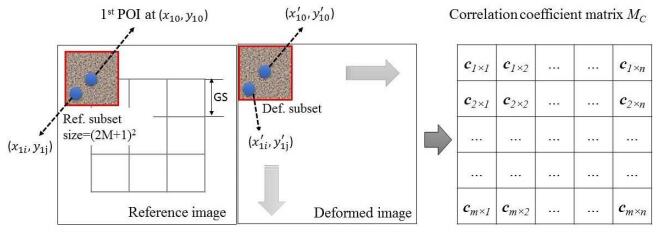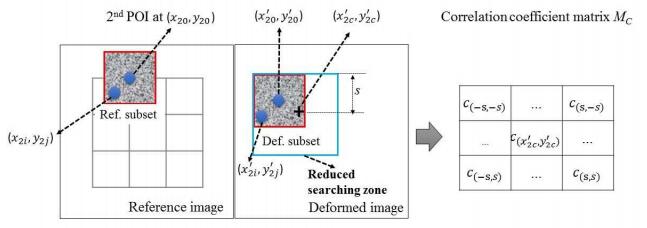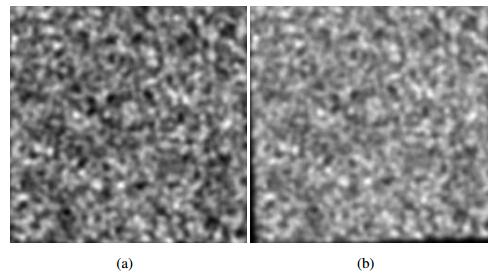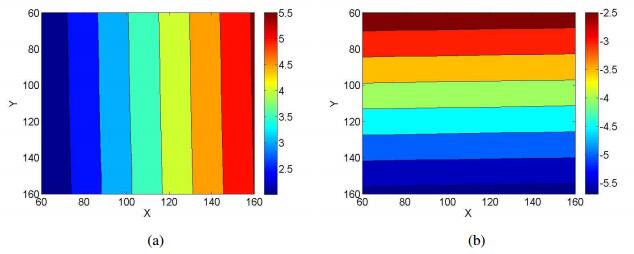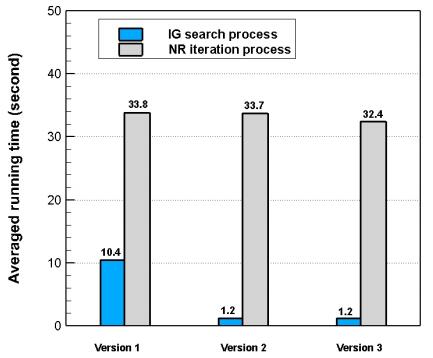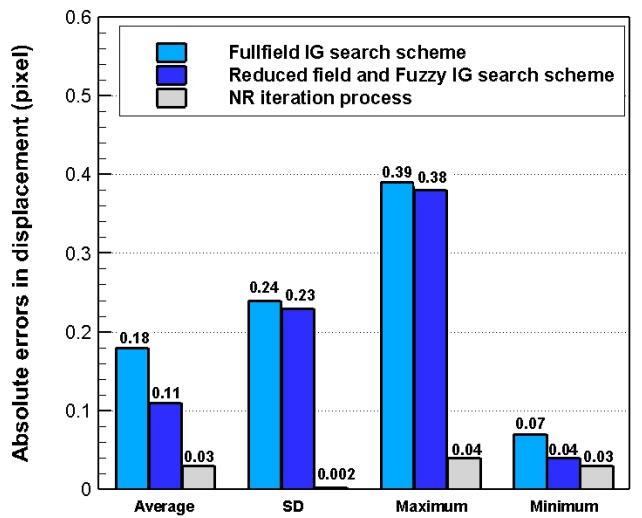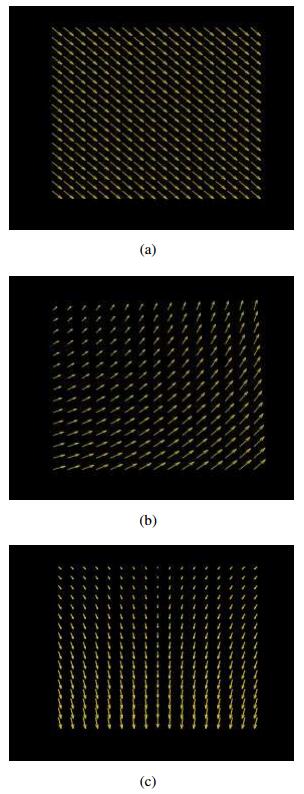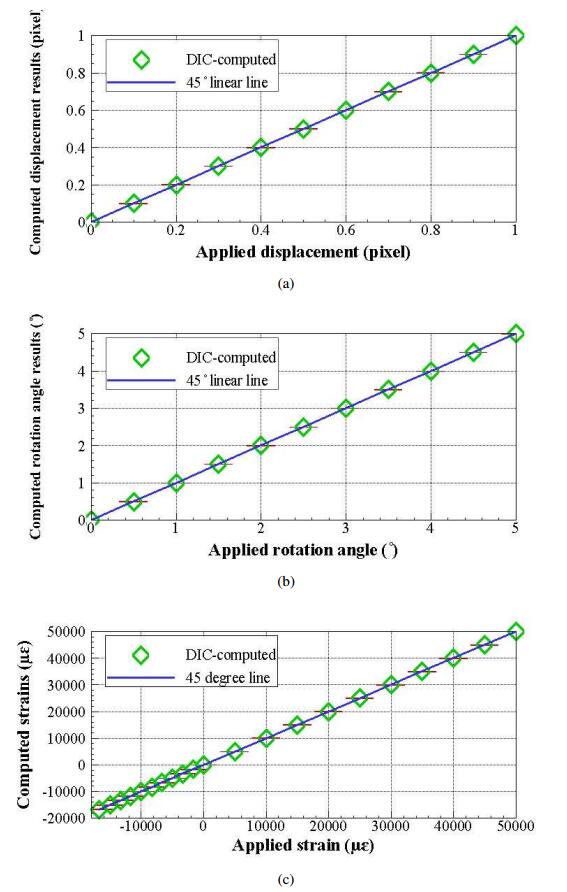The Digital Image Correlation (DIC) is now an effective method for measuring displacement in engineering fields. DIC includes a coarse search scheme with pixel-size accuracy for finding an initial guess (IG) followed by an iteration procedure to successively find the accurate/true displacements. The closer IG to the true displacement values, the higher the likelihood of convergence and the more efficient the convergence of the subsequent Newton-Raphson (NR) iteration procedure. This study introduced and verified a novel fuzzy-logic based approximation scheme intending to provide more accurate IG values after the standard full-field IG search scheme. The results based on numerical experiments showed that the novel step of IG searching scheme provided considerably more accurate IG values and reduced the computational costs of finding IG values by up to 88.5% compared to the standard scheme. Furthermore, the overall computational costs including the subsequent NR iteration procedure were reduced by 31.5%, which is substantial. To further test and demonstrate the robustness, accuracy and effectiveness of the novel DIC procedure, a large number of numerical experiments using images simulating a wide range of rigid body motions (rotation, translation) and tensile testing conditions was utilized. The results had a 98.8% accuracy rate and a 99% precision rate. The DIC procedure provided therefore efficient and accurate displacement/deformation measurements in different types of loading conditions which are used for studying the mechanics of acrylic medical bone cements that are of interest in our research laboratory.
1.
Introduction
The porous media fluid defined in a two-dimensional semi-infinite pipe has received extensive attention. Liu et al. [1] defined a semi-infinite strip pipe whose generatrix is parallel to the coordinate axis (see Figure 1) and obtained the Phragmén-Lindelöf alternative result of shallow water equations.
Payne and Schaefer [2] considered the case that the generatrix is not parallel to the coordinate axis (see Figure 2) and obtained the Phragmén-Lindelöf alternative for the biharmonic equation.
Recently, Li and Chen [3] considered the Darcy equations on a semi-infinite channel which was defined as
where a>0 and h(x1) is a smooth curve in the plane. They proved that the solutions of Darcy equations grow polynomially or decay exponentially as a spatial variable x1→∞. For more on such studies, one can see [2,4,5,6].
In this paper, we consider the convergence result on the Soret coefficient of the Darcy model in R. The importance of this type of convergence result was discussed by Hirsch and Smale [7] and there have been a lot of results. At first, people mainly focused on the structural stability of the solutions of various systems of partial differential equations in bounded domains (see [8,9,10,11,12,13,14]). Later, many scholars extended the study of structural stability to the case that there are two kinds of interface links in a bounded region (see [15,16,17,18]). Li et al. [19,20] considered the structural stability of Brinkman-Forechheimer equations and the thermoelastic equations of type III on a three-dimensional semi-infinite cylinder, respectively. The generatrix of the cylinder was parallel to the coordinate axis. However, the stability of partial differential equations on a two-dimensional pipe has not received enough attention. It is especially emphasized that the generatrix of the pipe considered in this paper is not parallel to the coordinate axis.
We investigate the following double-diffusive Darcy flow of a fluid through a porous medium in R which can be written as (see [21])
where α=1,2. uα,p,T and C represent the velocity, pressure, temperature, and concentration of the flow, respectively. gα and hα are bounded functions. σ>0 is the Soret coefficient. For simplicity, we assume g and h satisfy |g|, |h|≤1. In this paper, we also use the summation convention summed from 1 to 2, and a comma is used to indicate differentiation. e.g., uα,βuα,β=∑2α,β=1(∂uα∂xβ)2.
The initial-boundary conditions can be written as
where T0 and C0 are given functions. Fα, H and ˜H are differentiable functions which are assumed to satisfy the appropriate compatibility conditions
Now, we let v(x1,x2,t) denote a stream function which satisfies
Equations (1.1)–(1.8) can be converted to
where vn is the outward normal derivative of v, g=(g1,g2), h=(h1,h2) and ∇⊥=(∂x2,−∂x1).
In the next section, we give several lemmas that have been derived in the literature. In Section 3, we derive an important lemma that can be used to derive our main result. In Section 4, we obtain the convergence result on the Soret coefficient and give some concrete examples. Section 5 shows the summary and outlook of this paper.
2.
Preliminary
We also introduce the notations
where z is a running variable along the x1 axis.
Here are some lemmas that will be often used in this paper.
Lemma 2.1 (see [5,22]) If w(x1,0)=w(x1,h)=0 and wn(x1,0)=wn(x1,h)=0, then the following Wirtinger type inequality holds
where z>0 is a moving point on the x1 axis.
Lemma 2.2 If φ(x1,0)=φ(x1,h)=0 and φ→0, as x1→∞, then
Proof. Since φ(x1,0)=φ(x1,h)=0, we have
Since φ→0, as x1→∞, we have
Combining Eqs (2.1) and (2.2) and integrating over Rz, we obtain
Using Young's inequality, we can obtain Lemma 2.2.
Using a similar method of papers [9,23,24], we can have the following lemma.
Lemma 2.3 Assume that T0,H∈L∞, then
where Tm=max{||T0||∞, sup[0,τ]H∞(η)}.
If C0,˜H∈L∞ and σ=0 in (1.4), we can also have
where Cm=max{||C0||∞, sup[0,τ]˜H∞(η)}.
To obtain our main result, we shall use the following result which can be written as follows.
Lemma 2.4 (see [3]) Let (v,T,C) be a solution of the Eqs (1.1)–(1.10) in R and ∀ z≥a such that F(z,t)<0. Then for any fixed t
holds, where β1,β2,ω,m1,m2 and m3 are positive constants which depends on the middle parameter σ and boundary conditions of the equation; also F(z,t) has been defined as
Remark 2.1 Lemma 2.4 shows that the solution of Eqs (1.11)–(1.21) decays exponentially with z→∞. Only in this case, the study of structural stability is meaningful. Lemma 2.4 will also provide a priori bounds for the estimate of nonlinear terms (see e.g., (3.55) and (3.56)).
Remark 2.2 Li and Chen [3] considered several special cases of h(z), e.g., h(z)=h a constant, h(z)≤k1zτ1 and h(z)≤k2z(lnz)τ2, where k1,k2>0 and 0<τ1,τ2≤1. In the fourth section, we will also consider several special cases with h(z)=h as a constant, τ1=12,k1=1 and τ1=23,k1=1.
Lemma 2.5 (see [3]) Assume that (v,T,C) are solutions of Eqs (1.1)–(1.10). If F(z,t)<0 for any z≥a, then
where r(t) is a positive known function which depends only on t.
Now, we derive a bound of ∫Rv,αv,αdx2dξ.
Lemma 2.6 Assume that ˜F1,˜F2,H,˜H∈L∞(R), then
where
Additionally, r∗ is the maximum value of r(t) in [0,τ].
Proof. Using Eq (1.11), we have
Using Eqs (1.18)–(1.20) it follows that
Using Lemma 2.5 in Eq (2.5), we can get Lemma 2.6.
3.
Important lemma
In this section, we derive the convergence result when the Soret coefficient σ→0. To do this, we let (v,T,C) be the solution of Eqs (1.11)–(1.21). Furthermore, let (v∗,T∗,C∗) be the solution to the following equations
Remark 3.1 We note that Lemmas 2.4 and 2.5 also hold for (v∗,T∗,C∗).
Now, we let
Then (w,θ,Σ) satisfies
We establish the following auxiliary functions
where ω is an arbitrary positive constant.
Using the divergence theorem and Eqs (3.12)-(3.21), we have
Similarly, we have
and
We also define
where δ2 and δ3 are positive constants.
Using the Cauchy-Schwarz inequality, we have
Inserting Eqs (3.29) and (3.30) into Eq (3.28) and choosing ω=max{4δ3,4δ2}, we have
From Eq (3.28), we have
Using the Cauchy-Schwarz inequality, we have
Inserting Eqs (3.33) and (3.34) into Eq (3.32), we have
and
Based on Eqs (3.22)–(3.24) and using Eq (3.36), we have the following lemma.
Lemma 3.1. Assume that T0,C0,H,˜H∈C∞, 1h(z)∈C(R) and the function E(z,t) is defined in Eq (3.28). Then E(z,t) satisfies
where n1 is a positive constant.
Proof. Using the Hölder inequality, Young's inequality and Lemma 2.1, we have
Combining Eqs (3.22) and (3.38)–(3.40), we obtain
Using the Hölder inequality, Young's inequality, Lemmas 2.1, 2.3, 2.5 and Eq (2.5), we have
Using Lemma 2.3, we have
Inserting Eqs (3.42) and (3.45) into Eq (3.23), we obtain
Similarly, we have
and
Inserting Eqs (3.47)–(3.52) into Eq (3.24), we obtain
Now, inserting Eqs (3.41), (3.46) and (3.53) into Eq (3.28), choosing δ2<12T2m,δ3<14C2m and noting Eqs (3.36) and (3.31), we obtain
where
From Lemma 2.4, we have
Integrating Eq (3.55) from z to ∞, we get
Combining Eqs (3.54)–(3.56), we can obtain Lemma 3.1.
4.
Convergence results on the Soret coefficient
Based on Lemma 3.1, we derive our main results in this section. To do this, integrating Eq (3.37) from a to z, we obtain
To get the convergence results on the Soret coefficient, we have to derive the upper bound for E(a,t). To do this, we choose z=a in Eq (3.37) to get
By differentiating Eqs (3.22)–(3.24), then choosing z=a and using Eqs (3.19) and (3.20), it can be obtained that
Using the Hölder inequality, Young's inequality and Lemmas 2.3 and 2.5, we have
On the other hand, we choose z=a in Eq (3.36) to get
Inserting Eqs (4.4)–(4.6) into Eq (4.3) and noting Eq (4.7), we get
or
Inserting Eq (4.8) into Eq (4.2), we have
where n2=n1(h(a)+h32(a))4β2δ3r(t)+4δ3β3β2ωm1+4δ3β3β2ωm2.
Now, inserting Eq (4.9) into Eq (4.1) and in light of Eq (3.31), we can obtain the following theorem.
Theorem 4.1 Letting (w,θ,Σ) is solution of Eqs (3.12)–(3.21) with T0,C0,H,˜H∈C∞, then
Specifically
Next, we give some examples.
Remark 4.1 If h(z)=h is a positive constant, then
Therefore, we have
Choosing n1 such that 1n1≠2m3 and 1n1≠m3, then
and
Inserting Eqs (4.11)–(4.15) into Eq (4.10), we get
where
From Eq (4.16), we can conclude that Theorem 4.1 not only shows the convergence of the solutions of Eqs (3.12)–(3.21) on the coefficient σ, but it also shows a exponentially decay result as z→∞.
Remark 4.2. If h(z)=√z, then
Therefore
Moreover, we also have
and
Inserting Eqs (4.19)–(4.22) into Eq (4.10), we obtain
where
From Eq (4.23), we can conclude that Theorem 4.1 not only shows the convergence of the solutions of Eqs (3.12)–(3.21) on the coefficient σ, but it also shows a exponentially decay result as z→∞. Obviously, the decay rate is slightly slower than that in Remark 3.1.
Remark 4.3. If h(z) satisfies
then
Therefore, we have
Choosing n1>3, we get
and
Inserting Eqs (4.27)–(4.30) into Eq (4.10), we obtain
where
In this case, the inequality (Eq 4.31) not only shows the convergence of the solutions of Eqs (3.12)–(3.21) on the coefficient σ, but it also shows a exponentially decay result as z→∞.
5.
Conclusions
In this paper, the convergence of the solutions of Eqs (3.12)–(3.21) on the coefficient σ has been obtained and three examples have been given. Obviously, the convergence of various systems of partial differential equations defined on R is rare. But Eq (1.1) is linear. It will be meaningful to study nonlinear equations (e.g., Brinkman equations, Forchheimer equations) by using the method in this paper.
Acknowledgments
The authors express their heartfelt thanks to the editors and referees who have provided some important suggestions. This work is supported by the Tutor System Rroject of Guangzhou Huashang College (2021HSDS16).
Conflict of interest
All authors declare no conflicts of interest in this paper.
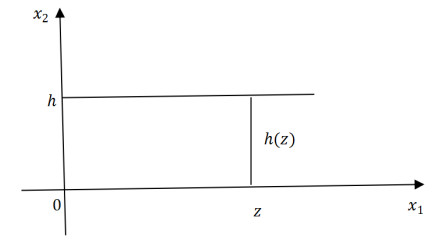









 DownLoad:
DownLoad:



